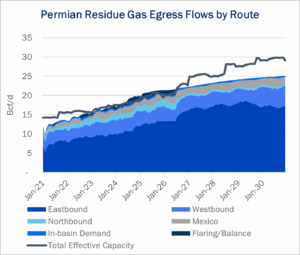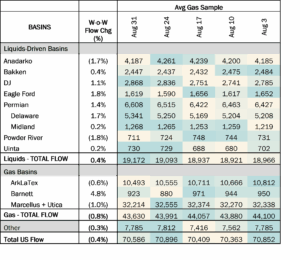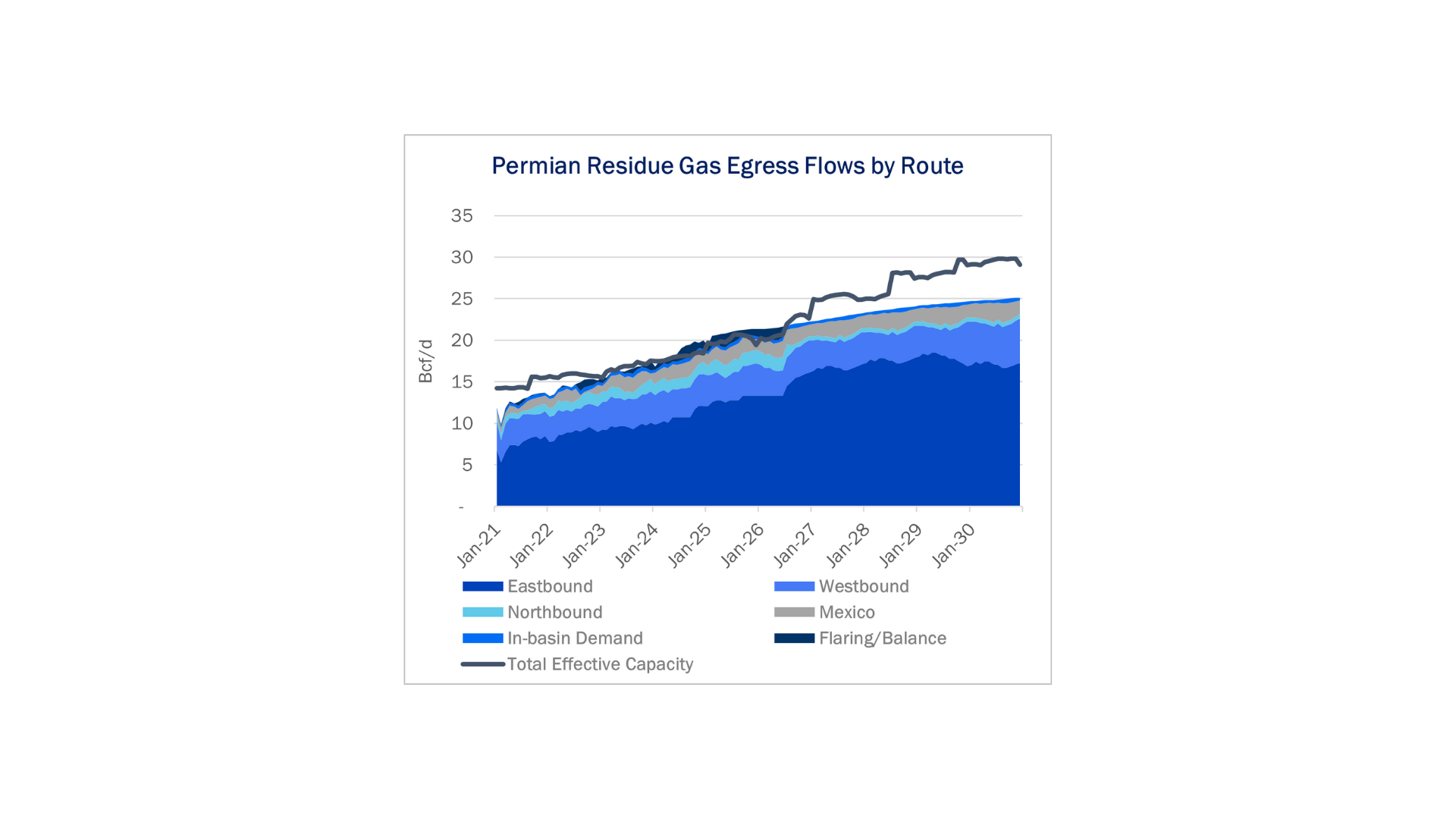Executive Summary:
Infrastructure: The Matterhorn JV made FID on Eiger Express, continuing momentum for new Permian gas pipelines.
Rigs: The US lost 5 rigs for the week of Aug. 23, bringing the total rig count to 523.
Flows: US natural gas volumes averaged 70.6 Bcf/d in pipeline samples for the week ending Aug. 31, down 0.4% W-o-W.
Storage: Traders expect the EIA to report a 25 Bcf injection for the week ending Aug. 22.
Infrastructure:
Momentum continues to grow behind new Permian Basin gas pipelines. The Matterhorn joint venture, consisting of WhiteWater, ONEOK (OKE), MPLX and Enbridge (ENB), announced a final investment decision (FID) last Monday (Aug. 25) on the new Eiger Express Pipeline.
Eiger Express would twin the existing Matterhorn Express line and add 2.5 Bcf/d of capacity from the Permian to the Katy hub near Houston. The pipeline is expected to be completed in mid-2028 and includes reserved capacity for deliveries to the Corpus Christi market, likely on WhiteWater’s Traverse Pipeline, a 1.5 Bcf/d bidirectional line linking the Katy and Agua Dulce hubs.
The Eiger Express joint venture is owned 70% by the Matterhorn JV, 15% by OKE and 15% by MPLX. WhiteWater will construct and operate the pipeline.

Eiger Express is the latest project targeting growing demand for gas from the Permian Basin. On Aug. 6, Energy Transfer (ET) announced a positive FID on an expansion of its Transwestern Pipeline, dubbed Desert Southwest. The project will add 1.5 Bcf/d of westward capacity to meet demand growth in New Mexico and Arizona, particularly in Maricopa County, one of the hotspots for data center expansion. Later, on the company’s earnings call, co-CEO Mackie McCrea said ET had already received calls from shippers demonstrating interest in further expansion capacity.
Desert Southwest will help address a supply shortage East Daley Analytics has flagged in the Southwest. The West Coast Supply & Demand Report sees growing demand for data center development and the expected startup of ECA LNG on Mexico’s Pacific coast driving a regional imbalance of over 1.6 Bcf/d by YE30.
In total, East Daley Analytics expects over 9.5 Bcf/d of new egress capacity out of the Permian over the next five years, not including potential expansions on Hugh Brinson, Desert Southwest, or Tallgrass Energy’s proposed Permian-to-Rockies Express connector. In the same period, we see production growth of just 4 Bcf/d, leading to a significant overbuild (see figure).
Our outlook has two caveats. First, some amount of overbuild, or underutilized capacity, is necessary to close the spread between Waha and Henry Hub, enabling Permian producers to receive better margins on their molecules. Second, we see potential for significant additional supply growth without rig adds, simply by moving rigs to gassier acreage on systems like Kinetik’s (KNTK) Alpine High.
These latest FIDs validate East Daley’s thesis that the value of Permian gas is increasing in the market. They also throw into question the view that the basin’s oil production will soon peak. For example, the Energy Information Administration currently expects US oil production to decline by 400 Mb/d in 2026, a forecast we disagree with. The Permian clearly has plenty of life left. The important question moving forward is: What is the optimal eastbound utilization that maintains strong Waha prices while maximizing volumes sold to LNG projects?
Rigs:
The US lost 5 rigs for the week of Aug. 23, bringing the total rig count to 523. The Bakken (+1) and Marcellus+Utica (+1) gained rigs while the Anadarko (-3), ArkLaTex (-1), Marcellus – NE PA (-1) and Permian (-1) lost rigs W-o-W.
At the company level, PSX (+4), KMI (+3), ET (+1) and XTO Energy (+1) gained rigs and TRGP (-5), KNTK (-2), EPD (-1), MPLX (-1), OKE (-1), WMB (-1), PBA (-1) and Aethon Energy (-1) lost rigs W-o-W.
See East Daley Analytics’ weekly Rig Activity Tracker for more information on rigs by basin and company.
Flows:
US natural gas volumes averaged 70.6 Bcf/d in pipeline samples for the week ending Aug. 31, down 0.4% W-o-W.
Major gas basin samples declined 0.8% W-o-W to 43.6 Bcf/d. The Haynesville sample decreased 0.6% to 10.5 Bcf/d, and the Marcellus+Utica sample fell 1.0% to 32.2 Bcf/d.
Samples in liquids-focused basins gained 0.4% W-o-W to 19.2 Bcf/d. The Permian sample rose 1.8%, the DJ increased 1.1% and the Eagle Ford sample was up 1.8%.

Storage:
Traders and analysts expect the Energy Information Administration (EIA) to report a 53 Bcf net injection for the week ending Aug. 29. A 53 Bcf injection would increase the surplus to the five-year average by 17 Bcf to 171 Bcf. The storage deficit to last year would fall 37 Bcf to 75 Bcf.
Inventory at the end of August inventory will total roughly 3,280 Bcf. Last year the Lower 48 crossed that mark during the week ending Aug. 9, so current inventories are about three weeks behind last year’s pace. In 2023, the Lower 48 passed 3,280 Bcf during the week ending Sept. 22, or about three weeks later than where storage currently stands. By the end of September, East Daley projects storage inventories will be close to 3,580 Bcf, on pace to surpass 3,900 Bcf by the end of October. In the past 15 years, inventory levels have surpassed 3,900 Bcf only five times in October: 2012, 2015, 2016, 2020 and 2024.
See the latest Macro Supply & Demand Report for more analysis on the storage outlook.

Calendar:

Subscribe to East Daley’s The Daley Note (TDN) for midstream insights delivered daily to your inbox. The Daley Note covers news, commodity prices, security prices, and EDA research likely to affect markets in the short term.



